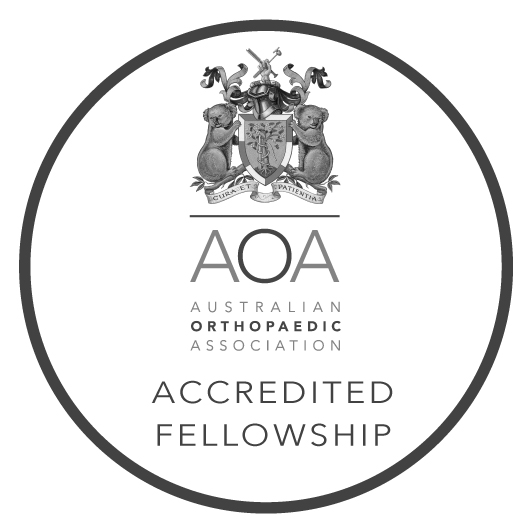Normal Anatomy of the Hip joint
Your anatomy

The hip is one of the largest weight-bearing joints in the body and consists of two main parts:
- The ball (femoral head) at the top of your thigh bone (femur)
- The rounded socket (acetabulum) in your pelvis
In a healthy joint, the hip allows rotation and movement of the upper leg from side to side and back to front, enabling a high level of pain-free mobility – walking, sitting, bending, turning, etc. Comprised of bones, muscles, ligaments, cartilage and tendons, each component must work harmoniously within a complex structural relationship in order to support the smooth and painless functioning of the joint.
The hip is a very stable joint – with the ball fitting into the rounded socket or cup-like cavity. Ligaments (tough chords of tissue) form a capsule connecting the ball to the socket, keeping the bones in position and helping to stabilise and control motion.
The surfaces of the ball and socket are covered by a smooth, tough material called articular cartilage, which cushions the bones and helps them to rotate more easily within the socket. The rest of the surfaces of the hip joint are covered by a thin, smooth tissue liner called synovial membrane. This secretes a small amount of synovial fluid which lubricates the joint, further reducing friction and facilitating movement. Bursae, fluid-filled sacs, cushion the area where muscles or tendons glide across bone.
Normal body movements rely on joints working smoothly and without pain – maintaining maximum joint function allows us to enjoy an active and fulfilling life.
The hip joint is the largest weight-bearing joint in the human body. It is also referred to as a ball and socket joint and is surrounded by muscles, ligaments, and tendons.
Any injury or disease of the hip will adversely affect the joint's range of motion and ability to bear weight.
Bones of the joint
The hip joint is comprised of two bones: the thigh bone or femur and the pelvis which is made up of three bones called ilium, ischium, and pubis. The ball of the hip joint is made by the femoral head while the socket is formed by the acetabulum. The Acetabulum is a deep, circular socket formed on the outer edge of the pelvis by the union of three bones: ilium, ischium and pubis. The stability of the hip is provided by the joint capsule and the muscles and ligaments which surround and support the hip joint.
The head of the femur rotates and glides within the acetabulum. A fibrocartilaginous collar called the labrum is attached to the acetabulum and further increases the depth of the socket.
Ligaments
Ligaments are fibrous structures that connect bones to other bones. The hip joint is encircled with ligaments to provide stability to the hip by forming a dense and fibrous structure within the joint capsule. The ligaments adjoining the hip joint include:
- Iliofemoral ligament – This is a Y-shaped ligament that connects the pelvis to the femoral neck at the front of the joint. It helps in limiting over-extension of the hip.
- Pubofemoral ligament – This is a triangular shaped ligament that extends between the upper portion of the pubis and the iliofemoral ligament. It attaches the pubis to the femoral neck.
- Ischiofemoral ligament – This is a group of strong fibers that arise from the ischium behind the acetabulum and merge with the fibres of the joint capsule.
- Ligamentum teres – This is a small ligament that extends from the tip of the femoral head to the acetabulum. Although it has no role in hip movement, it does have a small artery within that supplies blood to a part of the femoral head.
- Acetabular labrum – The labrum is a fibrous cartilage ring which lines the periphery of the acetabular socket. It deepens the cavitythereby increasing the stability and strength of the hip joint.
Muscles and Tendons
- Gluteals – These are the muscles that form the buttocks. There are three muscles (gluteus minimus, gluteus maximus, and gluteus medius) that attach to the back of the pelvis and insert into the greater trochanter of the femur.
- Adductors – These muscles are located in the thigh which help in adduction, the action of pulling the leg back towards the midline.
- Iliopsoas - This muscle is located in front of the hip joint and provides flexion. It is a deep muscle that originates from the lower back and pelvis, and extends up to the inside surface of the upper part of the femur. It is a flexor of the hip
- Rectus femoris – This muscle is part of the largest band of muscles located in front of the thigh. It is also a hip flexor.
- Hamstring muscles - These are attached at the lower end of the pelvis and run down the back of the thigh. Because they cross the back of the hip joint, they help in extension of the hip
Nerves and arteries:
Nerves of the hip transfer signals to and from the brain to the muscles around the hip. They also carry the sensory signals such as touch, pain, and temperature.
The main nerves in the hip region include the femoral nerve in the front of the hip and the sciatic nerve at the back. The hip is also supplied by a smaller nerve known as the obturator nerve.
There are blood vessels in front of the hip that supply blood to the lower limbs. The femoral artery, one of the largest arteries in the body, arises deep in the pelvis and can be felt in front of the upper thigh.
Hip movements:
Hip movements include flexion, extension, abduction, adduction, circumduction, and hip rotation.






